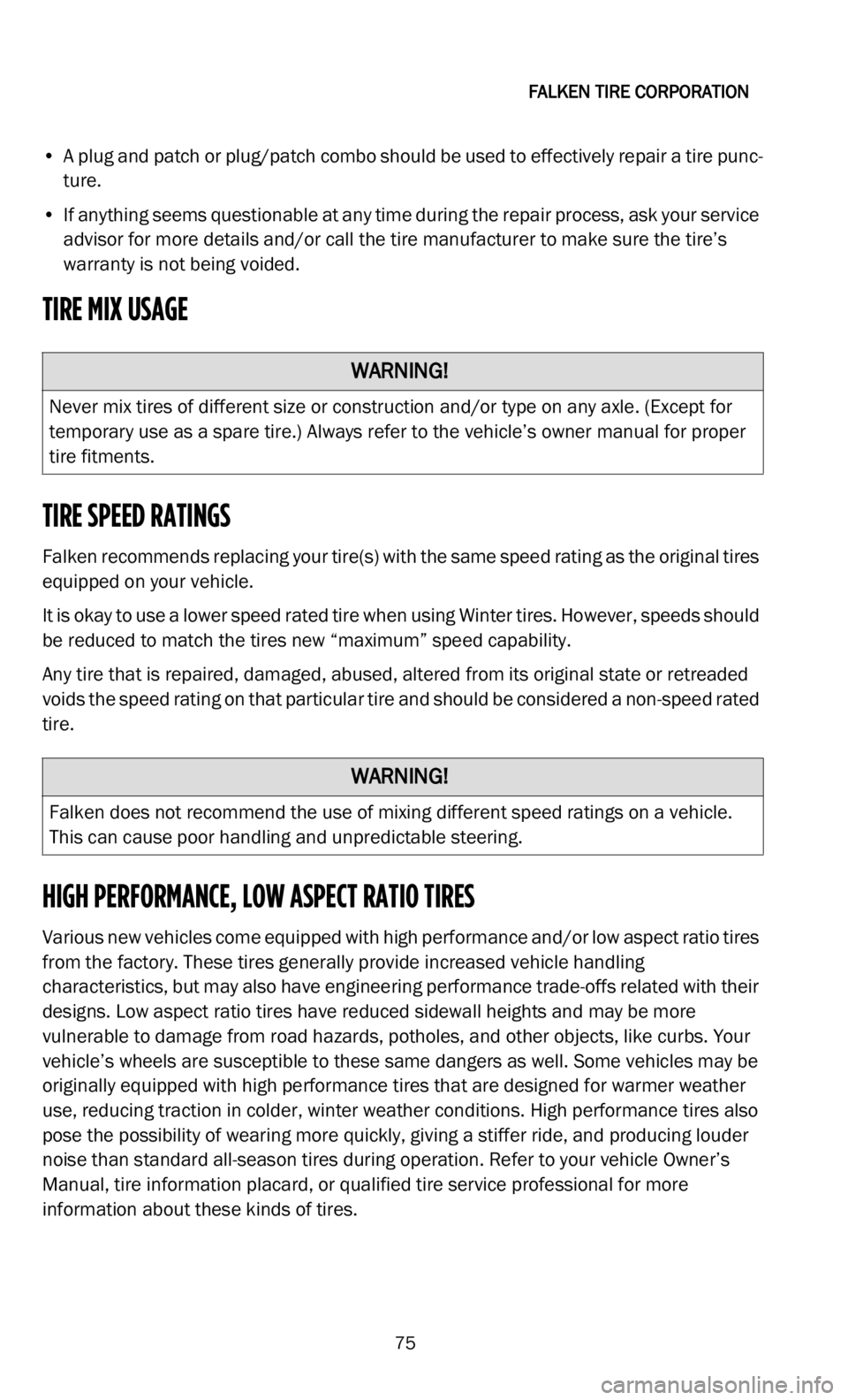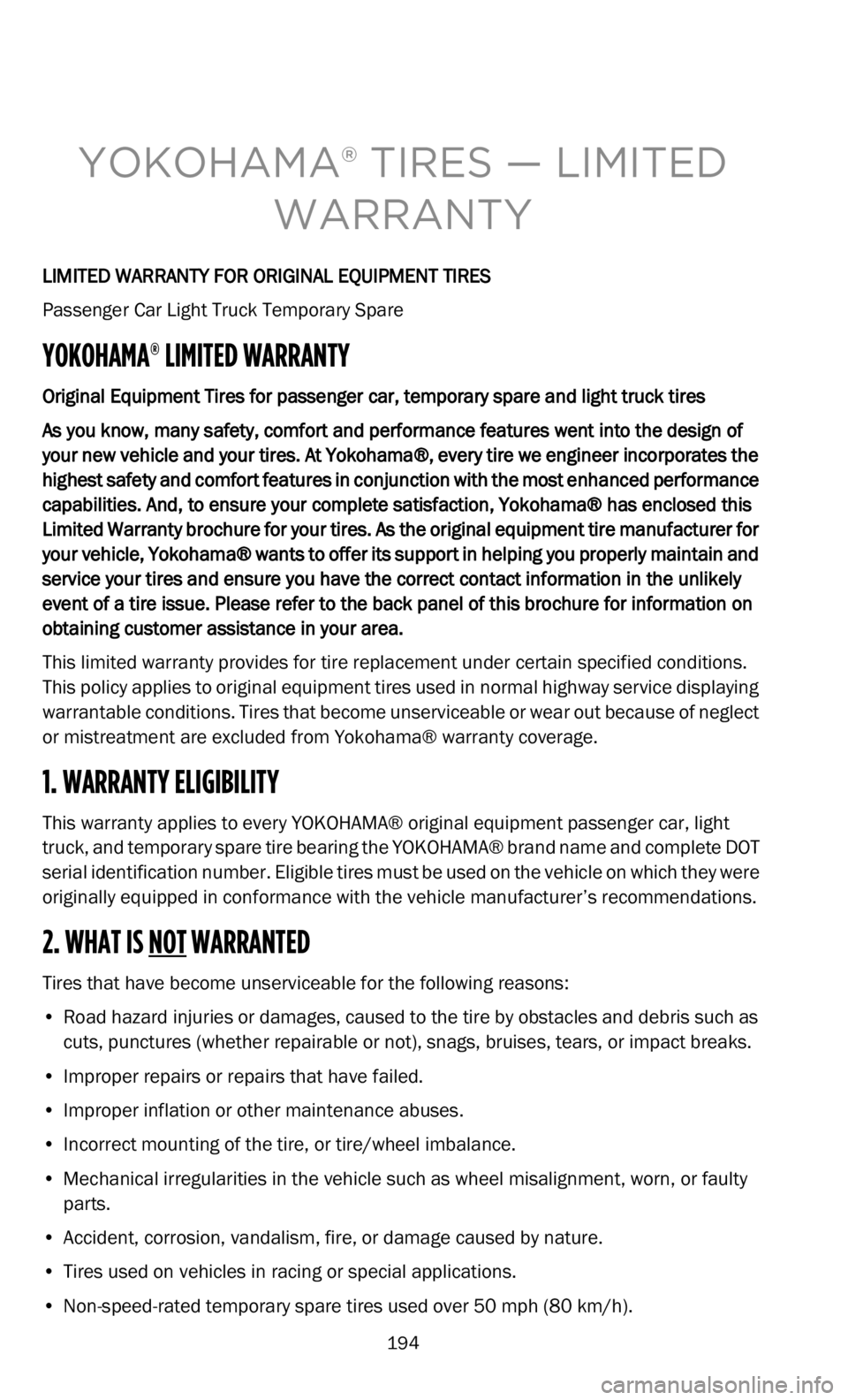engine DODGE DURANGO 2022 Vehicle Warranty
[x] Cancel search | Manufacturer: DODGE, Model Year: 2022, Model line: DURANGO, Model: DODGE DURANGO 2022Pages: 200, PDF Size: 6.72 MB
Page 26 of 200

BFGOODRICH® TIRES
25
TIRE PRESSURE MONITORING SYSTEM (TPMS)
Your vehicle may be equipped with a Tire Pressure Monitoring System (TPMS) that is
designed to monitor the pressure of tires mounted on your vehicle and sends a signal to
the driver if a tire pressure falls below a predetermined level. A TPMS should not replace
monthly manual pressure checks for all four tires and the spare. We recommend that you
manually monitor and check tire pressure inflation with a pressure gauge.
Your tires should have the recommended pressure listed by your vehicle’s manufacturer.
Th
is information can be found in the vehicle Owner’s Manual and often on a placard
located in the vehicle’s door jamb, inside the fuel hatch, or on the glove compartment
door. If you have a plus size fitment that requires a higher inflation pressure, your TPMS
will require re-calibration to the new inflation pressure. Refer to your tire dealer/installer
of plus size tires for proper inflation pressure.
We recommend checking air pressure once each month, and before a long trip. Whether
y o
u have a full-sized or mini-spare, make sure that it is properly inflated as well. If the
TPMS generates improper monitoring or signals we recommend that you consult your
Owner’s Manual provided with your vehicle and follow up with FCA US LLC.
TIRE SPINNING
Do not spin wheels in excess of 35 mph (55 km/h) as indicated on the speedometer.
Ex
cessive speed in a free-running, unloaded tire can cause it to “explode” from
centrifugal force. The energy released by such an explosion is sufficient to cause serious
physical injury or death. Never allow anyone to stand near or behind the spinning tire.
When in mud, sand, snow, ice or other slippery conditions, do not engage in excessive
w h
eel spin. Accelerating the motor excessively, particularly with automatic transmission
vehicles, may cause a drive tire that has lost traction to spin beyond its speed capability.
This is also true when balancing a drive tire/wheel assembly on the vehicle using the
vehicle engine to spin the tire/wheel assembly.
HIGH SPEED DRIVING CAN BE DANGEROUS
Correct inflation pressure is especially important. However, at high speeds, even with the
correct inflation pressure, a road hazard, for example is more difficult to avoid and if
contact is made, has a greater chance of causing tire damage than at a lower speed.
Moreover, driving at high speed reduces the reaction time available to avoid accidents
and bring your vehicle to a safe stop.
If you see any damage to a tire or wheel, replace it with the spare at once and visit a
pa
rticipating BFGoodrich® Tire Retailer.
Exceeding the maximum speeds shown on the following page for each type of
B F
Goodrich® tire will cause the tire to build up excessive heat which can cause tire
damage that could result in sudden tire destruction and rapid air loss. Failure to control
a vehicle when one or more tires experience a sudden air loss can lead to an accident.
In any case, you should not exceed reasonable speeds as indicated by the legal limits
a n
d driving conditions.
Page 48 of 200

BRIDGESTONE® - FIRESTONE®
47
This manual is not intended to provide proper training or service procedures for tire
mounting, demounting, balancing, rotation, or repair. Please leave these tasks to
qualified tire service professionals. For your safety and that of others:
• A lways stand well clear of any tire mounting operation. This is especially important
w
hen the service operator inflates the tire. If the tire has been improperly mounted, it
may burst with explosive force causing serious personal injury or death.
• T ires must match the width and diameter requirements of the wheels. For example,
1
6 inch diameter tires must only be mounted to 16 inch diameter wheels. Radial tires
m u
st only be mounted to wheels approved for radial tires.
• W heels must be free of cracks, dents, chips, and rust. Tires must be free of bead
d
amage, cuts, and punctures.
• N ever inflate a tire beyond 40 psi (275 kPa) to seat the beads. Be absolutely certain
b
eads are fully seated before adjusting inflation pressure to the level recommended
for vehicle operation.
• N ever put flammable substances in tire/wheel assemblies at any time. Never put any
f
lammable substance into a tire/wheel assembly and attempt to ignite to seat the
beads.
• A lways stand well away from the work area when tires are being spin balanced either
o
n or off the vehicle.
HIGH PERFORMANCE, LOW ASPECT RATIO TIRES
Many new vehicles come equipped from the factory with high performance and/or low
aspect ratio tires. Generally, these tires provide increased vehicle handling capability,
but may also have numerous engineering performance trade-offs associated with their
designs.
• Lo w aspect ratio tires, with reduced sidewall height, may be more susceptible to
d
amage from potholes, road hazards, and other objects such as curbs. This is true for
the wheels as well. Therefore, as with all other tires, it is important to drive with care
and maintain proper inflation pressure and load conditions. See “Tire Inflation Pres -
sure” and “Tire Damage, Inspection and Service Life” in this manual.
• Some sports cars and other handling performance enhanced vehicles, including s
edans and light trucks/SUVs, may be originally equipped with high performance tires
that are more optimized for warmer weather use. Colder, winter weather traction may
be reduced for these types of tires. Winter tires may be recommended by the vehicle
manufacturer for colder weather application. See “Winter Tires,” the next section in
this manual.
• H igh performance tires may also wear more quickly, ride more firmly, and produce
m
ore noise during operation.
Consult your vehicle Owner’s Manual and tire information placard, or a qualified tire
s e
rvice professional, for more information and specifics regarding these types of tires.
Page 76 of 200

FALKEN TIRE CORPORATION
75
• A plug and patch or plug/patch combo should be used to effectively repair a tire punc -
ture.
• I f anything seems questionable at any time during the repair process, ask your service
a
dvisor for more details and/or call the tire manufacturer to make sure the tire’s
warranty is not being voided.
TIRE MIX USAGE
TIRE SPEED RATINGS
Falken recommends replacing your tire(s) with the same speed rating as the original tires
equipped on your vehicle.
It is okay to use a lower speed rated tire when using Winter tires. However, speeds should
b e
reduced to match the tires new “maximum” speed capability.
Any tire that is repaired, damaged, abused, altered from its original state or retreaded
v o
ids the speed rating on that particular tire and should be considered a non-speed rated
tire.
HIGH PERFORMANCE, LOW ASPECT RATIO TIRES
Various new vehicles come equipped with high performance and/or low aspect ratio tires
from the factory. These tires generally provide increased vehicle handling
characteristics, but may also have engineering performance trade-offs related with their
designs. Low aspect ratio tires have reduced sidewall heights and may be more
vulnerable to damage from road hazards, potholes, and other objects, like curbs. Your
vehicle’s wheels are susceptible to these same dangers as well. Some vehicles may be
originally equipped with high performance tires that are designed for warmer weather
use, reducing traction in colder, winter weather conditions. High performance tires also
pose the possibility of wearing more quickly, giving a stiffer ride, and producing louder
noise than standard all-season tires during operation. Refer to your vehicle Owner’s
Manual, tire information placard, or qualified tire service professional for more
information about these kinds of tires.
WARNING!
Never mix tires of different size or construction and/or type on any axle. (Except for
temporary use as a spare tire.) Always refer to the vehicle’s owner manual for proper
tire fitments.
WARNING!
Falken does not recommend the use of mixing different speed ratings on a vehicle.
This can cause poor handling and unpredictable steering.
Page 99 of 200

GOODYEAR® DUNLOP® TIRES
98
DO CHECK YOUR TIRES FOR DAMAGE
Frequent (at least monthly) inspection of your tires for signs of damage and their general
condition is important for safety. If you have any questions, have your tire dealer inspect
them. Impacts, penetrations, cracks, knots, bulges or air loss always require tire removal
and expert inspection. Never perform a temporary repair or use an inner tube as a
substitute for a proper repair. Only qualified persons should repair tires.
PROPER TIRE REPAIR
Goodyear® does not warrant any inspection or repair process. The repair is entirely the
responsibility of the repairer and should be made in accordance with established Rubber
Manufacturers Association (RMA) procedures.
Tire Pressure Monitoring System (TPMS) Alert
Refer to your vehicle Owner’s Manual for more information on what to do if the Tire
Pressure Monitoring System (TPMS) alert activates.
THE CONVENIENCE (TEMPORARY) SPARE
The Convenience (Temporary) Spare is designed, built and tested to the high engineering
standards set by North America’s leading car manufacturers and to Goodyear®’s own
high standards of quality control. It is designed to take up minimum storage space and,
at the same time, fulfill the function of a spare tire when needed. The spare is kept in its
storage space, fully inflated at 60 psi. To be sure it is always ready for use, the air
pressure should be checked on a regular basis.
The Convenience (Temporary) Spare can be used in combination with the original tires
on
your vehicle. You can expect a tire tread life of up to 3,000 miles (4,800 kilometers),
d e
pending on road conditions and your driving habits. To conserve tire tread life, return
the spare to the storage area as soon as it is convenient to have the standard tire
repaired or replaced.
The Convenience (Temporary) Spare weighs less than a standard tire so it’s easier to
h a
ndle. It also helps reduce the total car weight, which contributes to fuel economy. The
wheels used with the Convenience (Temporary) Spare are specifically designed for use
with high pressure spares and should never be used with any other type tire.
DO NOT ATTEMPT TO MOUNT YOUR OWN TIRES
Serious injury or death may result from explosion of tire/rim assembly due to improper
mounting procedures. Follow tire manufacturer’s instructions and match tire diameter to
rim diameter. Mount light truck radials on rims approved for radial service. Do not apply
bead sealer. This can inhibit bead seating. Lubricate beads and tire rim (including tube
or flap) contact surfaces. Lock assembly on mounting machine or place in safety cage.
STAND BACK and never exceed 40 psi to seat beads. Never use a volatile substance or
a rubber “donut” (also known as a bead expander or “O-Ring”) to aid bead seating. Only
specially trained persons should mount tires.
Page 129 of 200

MICHELIN®
128
should have the recommended pressure listed by your vehicle’s manufacturer. This
information can be found in the vehicle Owner’s Manual and often on a placard located
in the vehicle’s door jamb, inside the fuel hatch, or on the glove compartment door. If you
have a plus size fitment that requires a higher inflation pressure, your tire pressure
monitoring system will require re-calibration to new inflation pressure. Refer to your tire
dealer/installer of plus size tires for proper inflation pressure.
We recommend checking air pressure once each month, and before a long trip. Whether
yo
u have a full-sized or mini-spare, make sure that it is properly inflated as well. If the
TPMS generates improper monitoring or signals we recommend that you consult your
Owner’s Manual provided with your vehicle and follow-up with your vehicle’s
manufacturer.
TIRE SPINNING
Do not spin wheels in excess of 35 mph (55 km/h) as indicated on the speedometer.
Ex
cessive speed in a free-running, unloaded tire can cause it to “explode” from
centrifugal force. The energy released by such an explosion is sufficient to cause serious
physical injury or death. Never allow anyone to stand near or behind the spinning tire.
When in mud, sand, snow, ice or other slippery conditions, do not engage in excessive
w h
eel spin. Accelerating the motor excessively, particularly with automatic transmission
vehicles, may cause a drive tire that has lost traction to spin beyond its speed capability.
This is also true when balancing a drive tire/wheel assembly on the vehicle using the
vehicle engine to spin the tire/wheel assembly.
HIGH SPEED DRIVING CAN BE DANGEROUS
Correct inflation pressure is especially important. However, at high speeds, even with the
correct inflation pressure, a road hazard, for example is more difficult to avoid and if
contact is made, has a greater chance of causing tire damage than at a lower speed.
Moreover, driving at high speed reduces the reaction time available to avoid accidents
and bring your vehicle to a safe stop. If you see any damage to a tire or wheel, replace it
with the spare at once and visit a participating Michelin® tire retailer.
Exceeding the maximum speeds shown on the following page for each type of Michelin®
t i
re will cause the tire to build up excessive heat which can cause tire damage that could
result in sudden tire destruction and rapid air loss. Failure to control a vehicle when one
or more tires experience a sudden air loss can lead to an accident.
In any case, you should not exceed reasonable speeds as indicated by the legal limits
a n
d driving conditions.
SPEED RATINGS
Speed Symbols are shown on the sidewall of some Michelin® tires. The following table
shows the maximum speed corresponding to the symbol.
*Some V (or VR) rated tires may have a speed capacity greater than 149 mph (240 km/h).
C o
nsult your participating Michelin® tire retailer for maximum speed rating if your vehicle
capability exceeds this speed.
Page 195 of 200

194
YOKOHAMA® TIRES — LIMITED WARRANTY
LIMITED WARRANTY FOR ORIGINAL EQUIPMENT TIRES
Passenger Car Light Truck Temporary Spare
YOKOHAMA® LIMITED WARRANTY
Original Equipment Tires for passenger car, temporary spare and light truck tires
As you know, many safety, comfort and performance features went into the design of
you
r new vehicle and your tires. At Yokohama®, every tire we engineer incorporates the
highest safety and comfort features in conjunction with the most enhanced performance
capabilities. And, to ensure your complete satisfaction, Yokohama® has enclosed this
Limited Warranty brochure for your tires. As the original equipment tire manufacturer for
your vehicle, Yokohama® wants to offer its support in helping you properly maintain and
service your tires and ensure you have the correct contact information in the unlikely
event of a tire issue. Please refer to the back panel of this brochure for information on
obtaining customer assistance in your area.
This limited warranty provides for tire replacement under certain specified conditions.
Th i
s policy applies to original equipment tires used in normal highway service displaying
warrantable conditions. Tires that become unserviceable or wear out because of neglect
or mistreatment are excluded from Yokohama® warranty coverage.
1. WARRANTY ELIGIBILITY
This warranty applies to every YOKOHAMA® original equipment passenger car, light
truck, and temporary spare tire bearing the YOKOHAMA® brand name and complete DOT
serial identification number. Eligible tires must be used on the vehicle on which they were
originally equipped in conformance with the vehicle manufacturer’s recommendations.
2. WHAT IS NOT WARRANTED
Tires that have become unserviceable for the following reasons:
• Road hazard injuries or damages, caused to the tire by obstacles and debris such as
cu
ts, punctures (whether repairable or not), snags, bruises, tears, or impact breaks.
• Improper repairs or repairs that have failed.
• Im
proper inflation or other maintenance abuses.
• In
correct mounting of the tire, or tire/wheel imbalance.
• Me
chanical irregularities in the vehicle such as wheel misalignment, worn, or faulty
p a
rts.
• Accident, corrosion, vandalism, fire, or damage caused by nature. • Ti
res used on vehicles in racing or special applications.
• No
n-speed-rated temporary spare tires used over 50 m
ph (80 km/h).